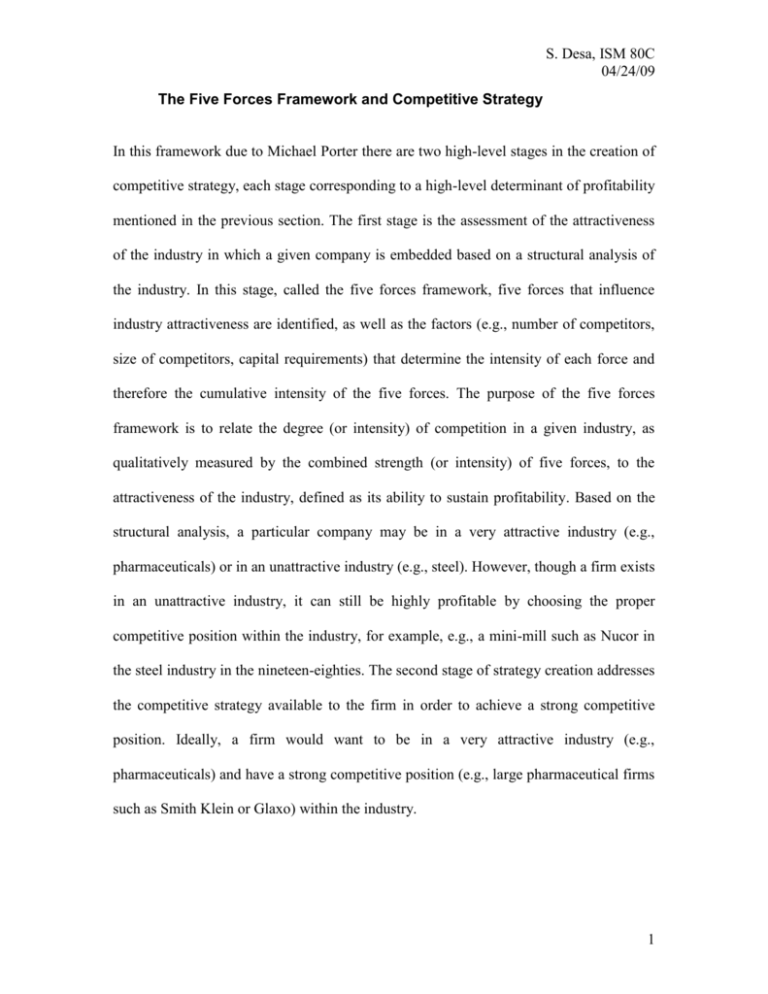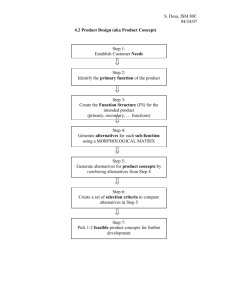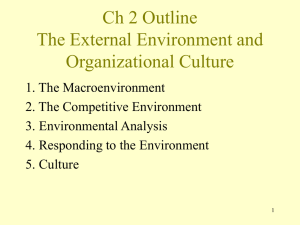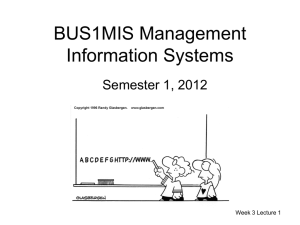The Five Forces Framework and Competitive Strategy
advertisement

S. Desa, ISM 80C 04/24/09 The Five Forces Framework and Competitive Strategy In this framework due to Michael Porter there are two high-level stages in the creation of competitive strategy, each stage corresponding to a high-level determinant of profitability mentioned in the previous section. The first stage is the assessment of the attractiveness of the industry in which a given company is embedded based on a structural analysis of the industry. In this stage, called the five forces framework, five forces that influence industry attractiveness are identified, as well as the factors (e.g., number of competitors, size of competitors, capital requirements) that determine the intensity of each force and therefore the cumulative intensity of the five forces. The purpose of the five forces framework is to relate the degree (or intensity) of competition in a given industry, as qualitatively measured by the combined strength (or intensity) of five forces, to the attractiveness of the industry, defined as its ability to sustain profitability. Based on the structural analysis, a particular company may be in a very attractive industry (e.g., pharmaceuticals) or in an unattractive industry (e.g., steel). However, though a firm exists in an unattractive industry, it can still be highly profitable by choosing the proper competitive position within the industry, for example, e.g., a mini-mill such as Nucor in the steel industry in the nineteen-eighties. The second stage of strategy creation addresses the competitive strategy available to the firm in order to achieve a strong competitive position. Ideally, a firm would want to be in a very attractive industry (e.g., pharmaceuticals) and have a strong competitive position (e.g., large pharmaceutical firms such as Smith Klein or Glaxo) within the industry. 1 S. Desa, ISM 80C 04/24/09 The five forces framework for the structural analysis of an industry is as follows. First, we define the following terms used in the structural analysis of the industry: industry, market, competitors, new entrants, substitutes, buyers, and sellers. The term industry denotes (1) the manufacturers (or producers) and (2) the suppliers of a primary product or service, as well as (3) the manufacturers of alternative products and services that could serve as a substitute. For example, the (conventional) personal computer (PC) industry would include PC manufacturers like Dell and Apple, suppliers of semiconductor chips like Intel and Micron, suppliers of disc drives like Seagate, suppliers of software such as Microsoft, etc. Substitute products could be pen-based tablet PCs or small hand-held personal digital assistants (PDAs). In the five forces framework described below, manufacturers and producers will be designated as (1) competitors in the industry if they already have established products, or (2) new-entrants if they are trying to enter the industry, or (3) substitutes, if they provide alternative (substitute) products. The term market denotes the buyers (or customers) of the product or service. For example, the market for PCs would include enterprises and individual consumers. The analytical process of strategy analysis and creation can be decomposed into the following five steps. 1. Create a map of the industry in which the technology company is embedded. There are five key sets of players that constitute the business landscape: competitors, new entrants, substitutes, suppliers, and buyers. Identify key players (companies) for each industry. 2 S. Desa, ISM 80C 04/24/09 2. Perform a five forces analysis of the industry structure. The five forces that influence the intensity of competition in a particular industry, and therefore the profitability of the firms within the industry: Force 1: the degree of rivalry (or competition) between the competitors; Force 2: the threat of new entrants (or the inverse of this force, the barrier to entry); Force 3: the threat of substitutes; Force 4: Buyer Power (to demand lower prices); Force 5: Supplier Power (to increase material prices). For each force, determine the key structural determinants which affect the intensity of the force. Porter provides a detailed set of the determinants for each force, some of which are given in the table below. In the last column of this table we indicate plausible values of each force for the PC industry in the nineteen nineties. Force Rivalry between competitors Barrier to entry Threat of substitutes Buyer Power Supplier Power Key Determinants Concentration (number) and size of competitors 3. Brand identity Economies of scale Brand identity Capital requirements Price/Performance of substitutes Switching costs Buyer concentration Buyer size (volume) Switching costs Supplier concentration Supplier size (volume) Switching costs Table 1 Strength of the force Medium to high Medium to high Low to medium Medium to high Low to medium 3 S. Desa, ISM 80C 04/24/09 In theory, one would, qualitatively determine the strength of each force, as indicated in the third column of the above table, and then determine the cumulative or combined intensity of the five forces. The collective intensity or strength of the forces will determine the structural strength of the industry, as characterized by attractiveness, or the profit potential of the industry. The profit potential is measured by the long term return on invested capital (ROIC). If the collective strength of the forces is high, as in the steel industry, then the corresponding profit potential or attractiveness is low, and vice-versa. At one extreme of this analysis is the perfectly competitive free market, where there are numerous firms all offering very similar products that cannot be differentiated (therefore, the force of rivalry is high), entry is free (therefore, the threat of both new entrants and substitutes is high), and bargaining power of both suppliers and buyers is low. Using the PC industry of the 1990’s as an example, the qualitative values of the forces shown in the last column of the above table would lead one to conclude that the cumulative strength of the five forces was medium to high, and therefore the attractiveness of the industry, i.e., its profitability, was medium to low. The PC industry in the nineteen-nineties would therefore not be attractive to new entrants, and in fact, in the early 2000s, HP’s computer business was unprofitable, and IBM sold its computer business to Lenovo. (It is important to note that HP’s unprofitability in computer business in the early 2000s cannot be attributed solely to industry attractiveness being low, but is also due to issues associated with its acquisition of the computer company Compaq.) 3. Select a competitive positioning strategy The basic premise of Porter and Hall was that for a firm to be successful (in a market) it had to compete based on one of two sources of competitive advantage: cost, i.e., by 4 S. Desa, ISM 80C 04/24/09 providing low cost products, or differentiation, i.e., by differentiating its products from its competitors with respect to quality and performance. Porter also proposed that a firm needs to select its strategic target: either offering a product to the entire market (“marketwide”), or offering a product for a particular market segment. Using these two dimensions (source of competitive advantage and strategic target), Porter proposed the following three generic competitive strategies: 1. Cost Leadership: offering the lowest costs products to the entire market 2. Differentiated: offering highly unique products (as perceived by the customer) to the entire market 3. Focus: offering products which serve the needs of a niche segment of the market Porter’s claim is that for a company to be successful in the industry in which it operates it must choose between one of the three generic strategies: cost leadership, differentiated, and focus. If one uses the personal computer industry in the US during the 1990’s as an example, then the competitive strategies of the major players was as follows: Dell was the low-cost leader; HP had a differentiated strategy with high-quality products; Apple had a focus strategy, targeting a narrow market segment of users who whom the userexperience (look, feel, and graphical user interfaces) were extremely important; and IBM had a mixed strategy. Reference: Michael E. Porter, ‘Competitive Strategy”, the Free Press, 1980. 5









